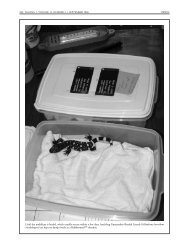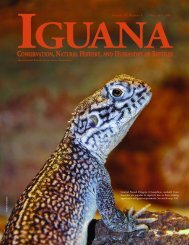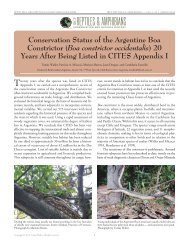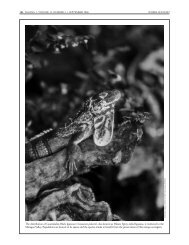Spiny-tailed Iguanas (Ctenosaura similis) in Venezuela
Spiny-tailed Iguanas (Ctenosaura similis) in Venezuela
Spiny-tailed Iguanas (Ctenosaura similis) in Venezuela
Create successful ePaper yourself
Turn your PDF publications into a flip-book with our unique Google optimized e-Paper software.
TRAVELOGUE<br />
Few liv<strong>in</strong>g th<strong>in</strong>gs can make you feel smaller or younger than oldgrowth<br />
forests. This open semi-dry region was near the beg<strong>in</strong>n<strong>in</strong>g of a<br />
treacherous three-hour hike to Kachibona Lake.<br />
This lens has a view<strong>in</strong>g angle wider than a human eye, and distorts<br />
straight l<strong>in</strong>es <strong>in</strong>to curves (note the trees <strong>in</strong> wide angle<br />
shots). However, small objects can be emphasized aga<strong>in</strong>st a large<br />
background, and thus given a context that a normal lens would<br />
not allow.<br />
A Mart<strong>in</strong>ique Frog (Eleutherodactylus mart<strong>in</strong>icensis) and Craig Berg’s<br />
<strong>in</strong>timidat<strong>in</strong>g hands are only a few centimeters from the fisheye lens.<br />
This was taken without a flash, us<strong>in</strong>g only the patchy light filter<strong>in</strong>g<br />
through the canopy.<br />
IGUANA • VOLUME 15, NUMBER 3 • SEPTEMBER 2008 167<br />
Much of my work was done at night, and operat<strong>in</strong>g a camera<br />
while dodg<strong>in</strong>g ra<strong>in</strong>drops and attempt<strong>in</strong>g to take field notes<br />
became quite a challenge. Flashes operate just f<strong>in</strong>e without<br />
ambient light, but that’s not true for the autofocus feature.<br />
Thankfully, we had solutions strapped to our heads. Our nighttime<br />
activities were all conducted with headlamps. Usually, a colleague<br />
was available to shed enough light on a subject to give our<br />
cameras a chance to focus, but work<strong>in</strong>g alone required more<br />
appendages than the number typically allotted to people (admittedly,<br />
a tripod would have helped, but data collection almost<br />
<strong>in</strong>variably precluded its use). A solution was to frame a picture,<br />
then move my head away from the camera to angle the light on<br />
a subject just <strong>in</strong> front of the lens. Autofocus makes a dist<strong>in</strong>ctive<br />
noise when it stops “hunt<strong>in</strong>g” for the subject and f<strong>in</strong>ds a focal<br />
po<strong>in</strong>t. Depress<strong>in</strong>g the shutter immediately after this happens<br />
without look<strong>in</strong>g at the viewf<strong>in</strong>der is hardly a foolproof method,<br />
but was sometimes the only option. Fortunately, most of the<br />
animals we encountered at night were asleep or happily<br />
ensconced on a stable perch and could be readily approached.<br />
Some of these provided a wonderful excuse to take off the bl<strong>in</strong>ders<br />
we wore to anyth<strong>in</strong>g not related to amphibians or reptiles.<br />
Unfortunately, many of these creatures were mobile, and some<br />
<strong>in</strong>sect pictures were possible only because biological urges (sex<br />
and food) kept them from scuttl<strong>in</strong>g out of the frame. Because I<br />
too was fixated on frogs and lizards, I often needed a few<br />
moments to realize what I was see<strong>in</strong>g when encounter<strong>in</strong>g <strong>in</strong>sects<br />
at night.<br />
One of our first nocturnal hikes <strong>in</strong>volved a narrow trail<br />
along a 45° slope <strong>in</strong> the midst of organic plastic-wrapped banana<br />
trees. What first seemed to be a walk<strong>in</strong>g stick a few feet from my<br />
head turned out to have considerably more than the usual number<br />
of legs and antennae. After count<strong>in</strong>g more than 12<br />
appendages, I eventually located two heads of animals engaged<br />
<strong>in</strong> an aerial ballet of significant sexual dexterity.<br />
Cannibalism was another activity well suited to macro photography.<br />
After complet<strong>in</strong>g an uneventful survey along a trail<br />
beh<strong>in</strong>d the Syndicate Nature Centre, we aga<strong>in</strong> encountered an<br />
animal with too many legs. This time, however, only enough<br />
limbs to account for one and a half <strong>in</strong>sects were present. A large<br />
This grasshopper is feast<strong>in</strong>g on another of its species. The genders<br />
<strong>in</strong>volved and what events led to this macabre spectacle are unknown.<br />
Sexual cannibalism is rare <strong>in</strong> <strong>in</strong>sects outside of mantids, but is known<br />
to occur <strong>in</strong> crickets.








